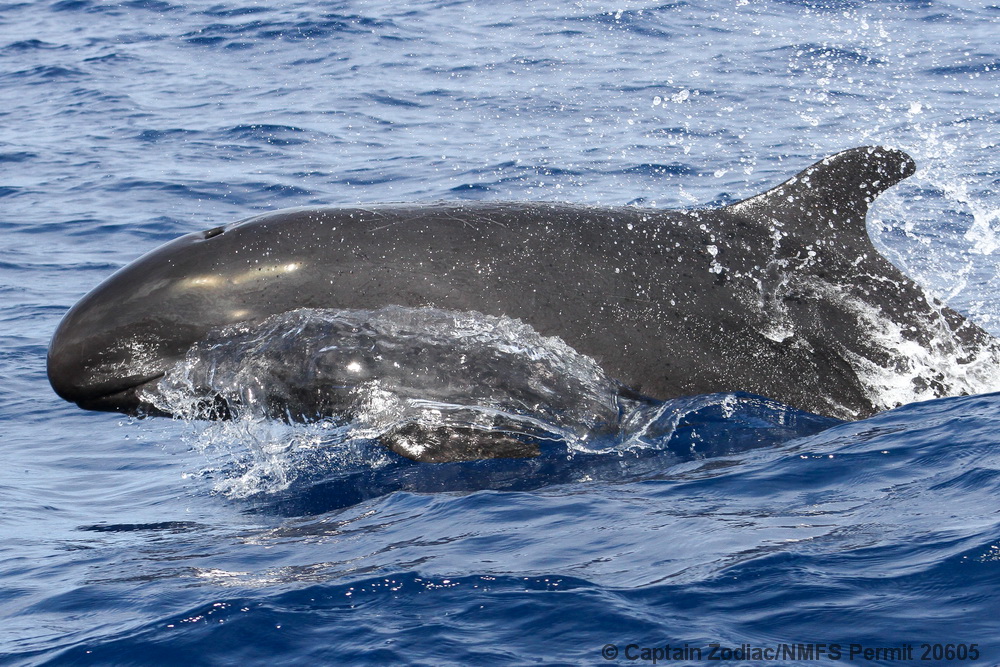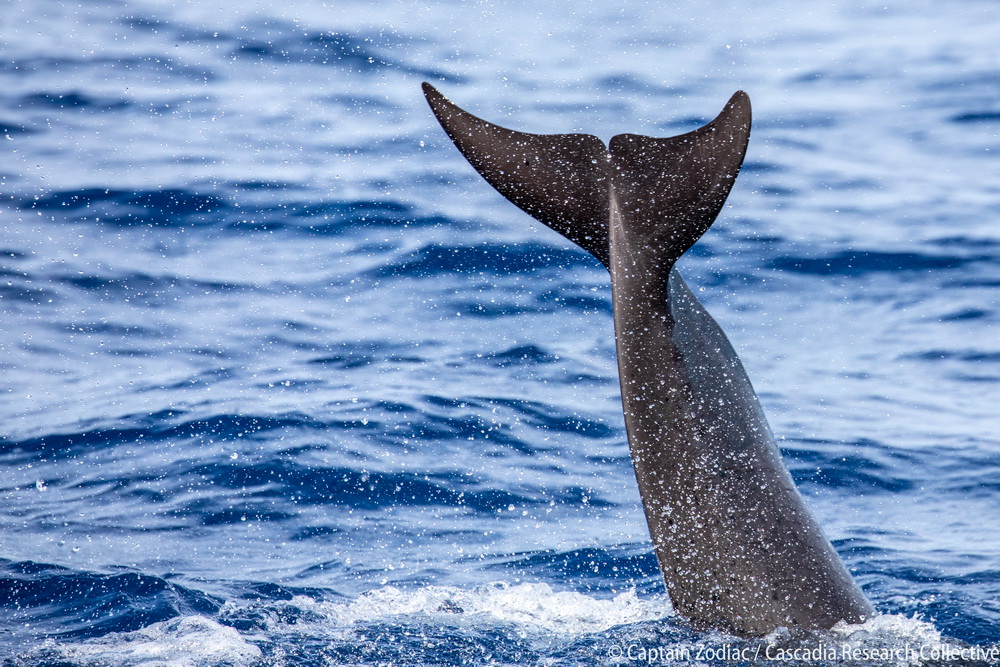While our field projects are normally undertaken during two- to three-week periods where we go out on the water every day, this summer we are trying a new option that has been made possible with the support of Captain Zodiac, a tour company based in Kona that has been contributing photos to our projects for a number of years. One of our primary field crew, Colin Cornforth, is one of the co-owners of Captain Zodiac, and also our primary tagger and biopsier on recent field projects. Since tour operations have shut down for a period of time in Hawai‘i, Colin and several crew from Captain Zodiac are able to use one of their vessels to take advantage of weather windows when the trade winds are light or variable. On these days they are able to head offshore for limited photo-identification and biopsy sampling with all species, and when they see false killer whales, our highest priority species, may also tag individuals. We’ll be posting photos from most days they get out on this page (below the tracking map), so check back regularly for information on progress. The primary field crew for this effort are Colin Cornforth, Andrea Gutierrez, Amanda Nix, and Brittany Guenther.
September 29th update
The team has been making it out on the water every week or two and having productive days. But today was an epic day, with an interesting and very productive encounter with false killer whales! As well as getting IDs of individuals from Clsuter 3 of the endangered main Hawaiian Islands population, the team witnessed four predation events on mahi mahi, and deployed a satellite tag on one individual!
We commonly observe false killer whales catching mahi mahi, and unlike other fish they eat the seem to like playing with mahi mahi.
The only other encounter today was a group of short-finned pilot whales, but the encounter was unusual in terms of the amount of breaching that was observed – not a behavior seen very often with this species! The photo above shows one of the pilot whales breaching.
A close up of a breaching short-finned pilot whale.
August 8th update
Another day offshore with two rarely-seen species, Risso’s dolphins and sperm whales! The two species were initially relatively close together, but the team concentrated on the Risso’s dolphins, given how rarely-seen this species is (only our 14th encounter in Hawaiian waters).
The Risso’s spent a lot of their time surfing! But even with the surfing we were able to get ID photos of about 15 individuals, so are looking forward to comparing them both to the encounter from July and to our catalog.
The sperm whale group was quite a large one, with an estimated 25 individuals spread out over several kilometers.
We also collected one large squid, as part of a study of cephalopods in Hawaiian waters. This specimen will be went to William Walker at the Marine Mammal Lab in Seattle – it is likely a species in the genus Onykia that has not yet been described (currently referred to as Onykia sp. A). This is likely a deep-water species that was brought up to the surface by a deep-diving whale such as sperm whales or one of the beaked whales. For more information on this study of cephalopods see a poster presentation at this link.
July 14th update
Today we found a group of Risso’s dolphins offshore of Kona! This is only the 13th encounter we’ve had with Risso’s dolphins in our work in Hawaiian waters, and the first encounter with this species since June 2017! We have a small photo-ID catalog of Risso’s dolphins, containing about 100 individuals, but so far we’ve had no re-sightings, suggesting that they are not resident to the islands.
We were able to get ID photos of about 12 of the 15 individuals in the group, so are looking forward to comparing them to our catalog. For more information on Risso’s dolphins in Hawaiian waters check out web page for this species.
The second offshore species seen today was a group of about 24 sperm whales, that included one newborn calf, seen above. Sperm whale individuals are typically identified using fluke photos, but as is typical of this species in Hawaiian waters this group was not fluking (although we do take dorsal fin photos as well).
During the sperm whale encounter we were able to collect one biopsy sample for genetics. For more information on sperm whales in Hawaiian waters check our web page for that species.
The third offshore species encountered today was a group of about 60 striped dolphins.
In addition to all the other sightings, we encountered a group of pantropical spotted dolphins. While they aren’t one of our highest priority species, we do record information on every group encountered, contributing to the understanding of how this species uses Hawaiian waters.
June 22nd update

A call from a friend about false killer whales led to a great encounter today, with members of Cluster 1 from the endangered main Hawaiian Islands population. As well as identification photos of about a dozen individuals we were able to deploy a satellite-tag on one individual, so are hoping to track its movements over the next few months. The individual that was tagged was identified as HIPc202 in our catalog, an adult male first documented off Maui in 2005 and seen regularly since.

The same individual was satellite tagged in July 2008 and over the 56-day period it remained around the north end of the Hawai‘i Island. This is only the third time we’ve tagged the same individual false killer whale twice, so it will provide a great opportunity to assess variability in behavior.

June 14th update
Today we were able to survey far offshore of Kona, onto the slopes of Indianapolis Seamount, and encountered five different species of odontocetes, including a group of about 35 Fraser’s dolphins. Like the encounter from April, individuals in this group were mixed in with a much larger group of melon-headed whales, and were surprisingly interested in the vessel, getting close enough for us to collect another biopsy sample, only our second ever from this species!
 \
\
Fraser’s dolphins are sexually dimorphic as adults, both in terms of coloration (the adult males have wide black stripes extending from their head towards their tail) and in dorsal fin shape (adult males have very triangular dorsal fins). In the photo above you can see two adult males along with several females or sub-adults.
The melon-headed whale group size was estimated at about 250 individuals. Given the location these individuals were from the Hawaiian Islands population, with individuals that broadly range offshore and among the islands. For more information on melon-headed whales in Hawaiian waters check out our melon-headed whale web page.
June 7th update
The team had another productive day on the water June 7th, with encounters with five species, including Cuvier’s beaked whales. This adult female Cuvier’s beaked whale, HIZc007 in our photo-ID catalog, was first documented off Hawai‘i Island in 2004 and last seen in 2017. There is a small resident population of Cuvier’s beaked whales off the island – check out our Hawai’i beaked whale page for more information.
The team left the Cuvier’s in response to a large whale in the distance, which turned out to be an adult male sperm whale!
An adult male sperm whale off Kona, June 7th, 2020. Sperm whales are seen offshore of Kona semi-regularly – part of a large widely-ranging population. Lone adult males are relatively rare however.
This individual had two linear wounds on the back, evidence of a previous vessel strike.
May 14th update
False killer whales are our primary focus species for several reasons. There is a small endangered population around the main Hawaiian Islands, and the pelagic population, which overlaps in range, is the population which is bycaught most frequently in the offshore longline fishery. While we’d be overjoyed to encounter groups from either population, there is a lot less known about the pelagic population and encounters are few and far between. Today the team encountered a group of pelagic false killer whales off Kona, and it was a very productive encounter! As well as getting identification photos of close to 30 individuals, the team collected one biopsy sample, and deployed a satellite tag to track the group!
This is only the third time we’ve tagged pelagic false killer whales (and the sixth time individuals from this population have been tagged – the NMFS Pacific Island Fisheries Science Center has also tagged three groups), so if the tag continues to transmit for a period of time we stand to learn a tremendous amount from this group.
The team took thousands of photos of the group, so it will be a while before we are able to confirm who was present, but we’ve already made several matches to the last group of pelagic false killer whales we’d encountered, from October 2013! We tagged several individuals in that group and the resultant track showed movements up to 1,700 km from the islands, so are excited to see where this group goes again!

Over the last 20 years we’ve only seen Fraser’s dolphins on four occasions, so the sighting April 9th was quite unexpected! The team was able to collect a biopsy sample from one individual in this group, the first biopsy we’ve ever been able to get from this species. The group was associated with a group of melon-headed whales, a species they are often seen traveling with. For more info on Fraser’s dolphins check out this web page.
On their second day out (May 5) they also encountered another offshore species, striped dolphins! This is another species that typically avoids boats. Check out our striped dolphin page for more information on this species.
Thanks to Captain Zodiac for their support!
Photos on this page were taken under NMFS Permit No. 20605. Contact Robin Baird (rwbaird “at” cascadiaresearch “dot” org) for more information.
Check out our previous Hawai‘i field projects at this page.
For more information and updates on our research follow us on Facebook!